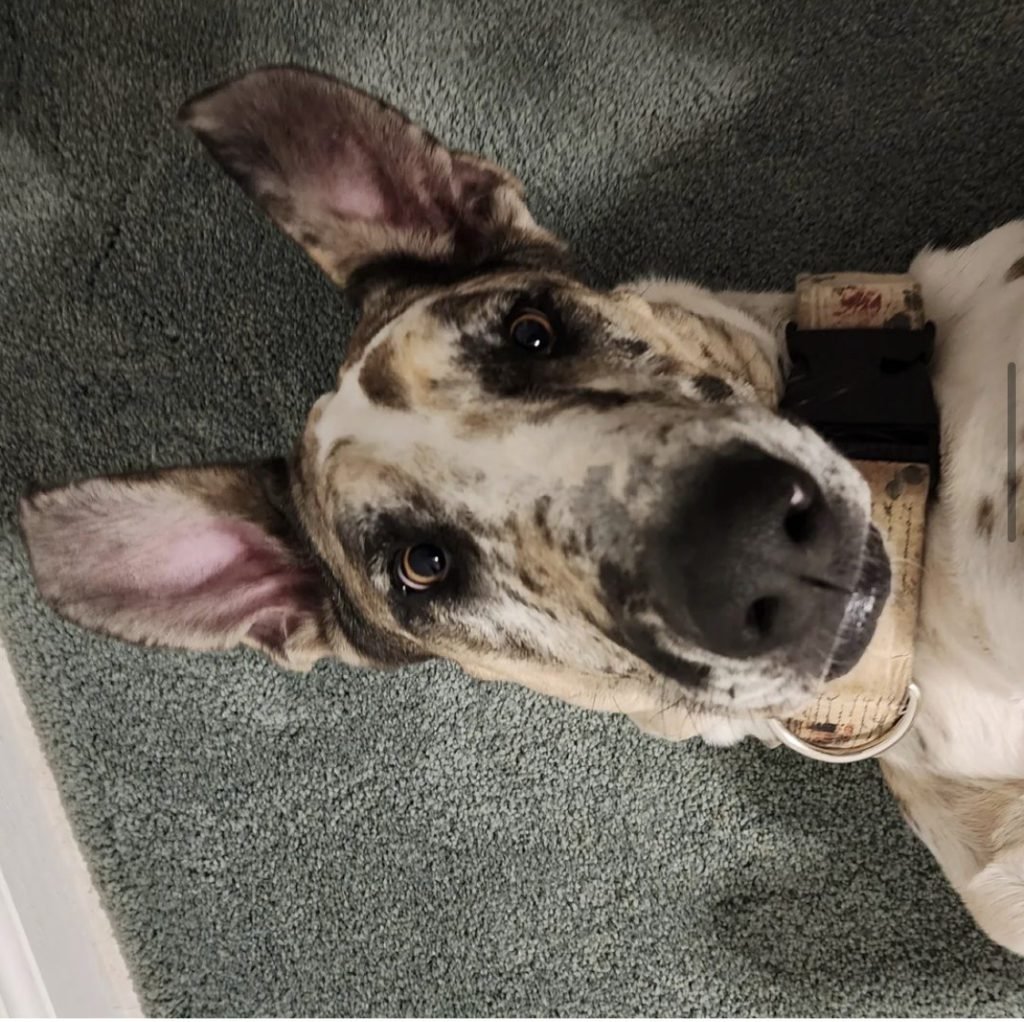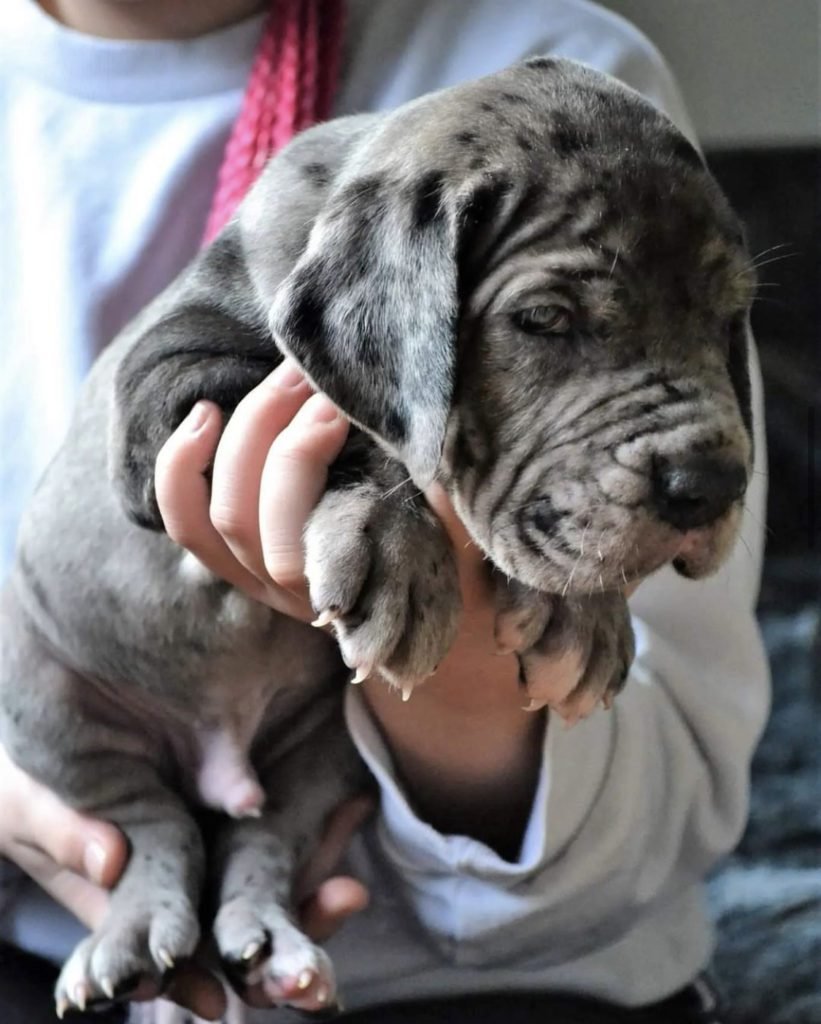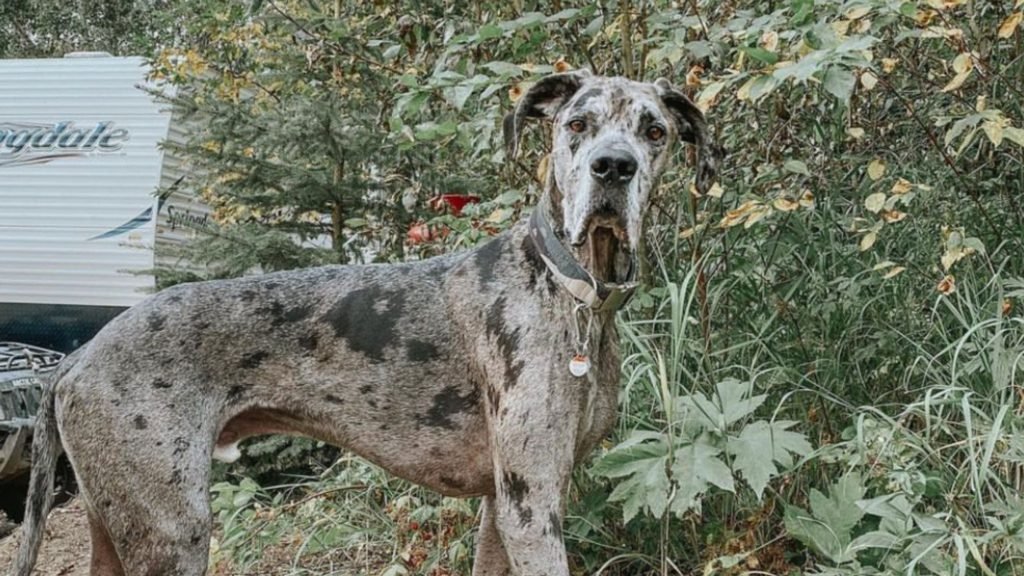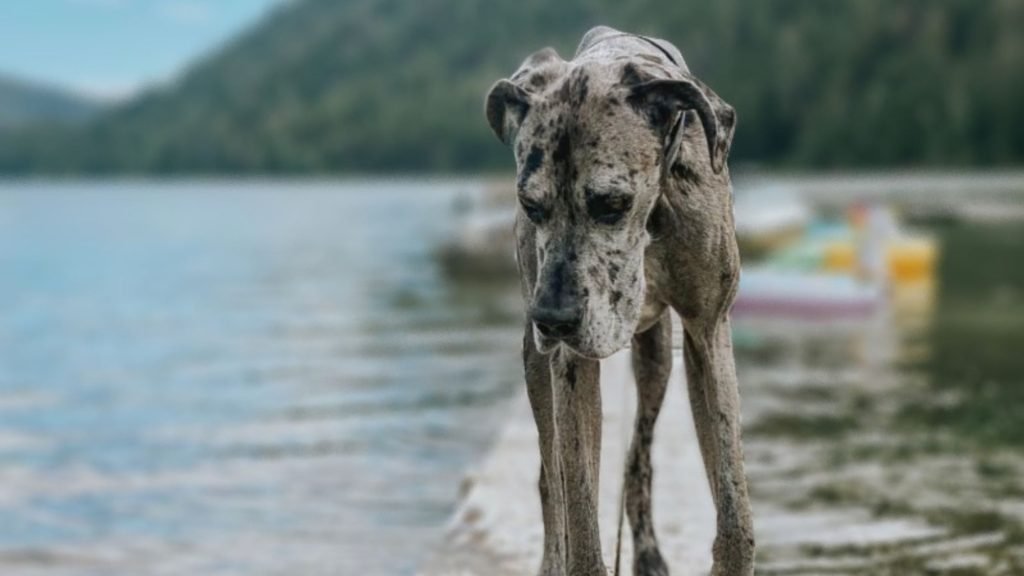The Merle Great Dane is a particular type of Great Dane known for its unique coat color. A mix of blue, black, and gray colors create a beautiful and striking pattern. This color has become very popular recently, and many people are choosing to adopt a Merle Great Dane as their new pet.
Before you bring a Merle Great Dane into your home, it’s essential to know that this breed is large and needs a lot of space. They also require a lot of exercise and training to keep them healthy and happy.
Another thing to consider is that the Merle Great Dane is a friendly and gentle dog, making them great companions for families with children. They are also known for their loyalty and intelligence, which makes them easy to train.
How to recognize a Great Dane Merle?
Great Danes are known for their beautiful coat colors and patterns. One of the most popular colors is the Merle Great Dane. This type of Great Dane has a gray base color with darker gray spots or markings all over its body.
You can find The Merle pattern in Great Danes and other dog breeds like Australian Shepherds and American Bullies. The gray color can vary in shades, but the standard is neutral gray.
Sometimes people confuse the Merle Great Dane with the Harlequin Great Dane. Even though they look similar, there is a big difference between them. The Harlequin Great Dane has a white base coat with black markings, while the Merle Great Dane has a gray base coat.

How is the color Merle in a Great Dane produced?
A particular gene produces the Merle color in a Great Dane. We found this gene in the puppy’s mother and father. When we cross two Great Danes with the Merle gene, there is a chance that their puppies will have the Merle color too. Another way to get a Merle Great Dane is to breed a harlequin Great Dane with a regular Great Dane. The harlequin Great Dane has the Merle gene.
It’s important to note that if two Merle Great Danes mix, there is a chance for the puppies to have health problems. That is because they will have two copies of the Merle gene. So, it’s essential to be careful when breeding these dogs to ensure they are healthy.
Knowing that both parents don’t need to be Merle is important. As long as at least one parent has the gene, there is a chance for the puppies to have the Merle color.
Is it unusual to find a Great Dane with a Merle coat?
It is important to recognize that a breeder’s claim that a specific color is uncommon does not necessarily reflect reality. Merle Great Danes are no rare than other Great Dane colors, so don’t let a breeder convince you to pay more for a Merle puppy.
When looking for a Great Dane puppy, it’s essential to focus on finding a reputable breeder who prioritizes the health and well-being of their dogs. Whether you choose a Merle or any other color, do your research and choose a responsible breeder.
Types of Merle Great Danes.
The Merle Great Dane comes in different patterns. The coat is short, thick, and shiny. Each Merle Great Dane looks unique because the Merle gene is sometimes rare. The standard pattern is a gray base with dark gray spots all over the body. Some of the most common Merle patterns are:
- Solid Merle: This pattern has a light or dark gray base color with black spots all over the body. These Great Danes may have white on their chest and toes.
- Blue Merle: This pattern is blue with dark spots all over the body. This pattern is usual, and you can find it easily.
- Merle Coat: This pattern has white fur on the muzzle, legs, and chest. This pattern is different from the others because it has white hair.
Characteristics of a Merle Great Dane.
Size: On average, a male Merle Great Dane is between 30 and 32 inches, and in the case of females, they can reach up to 30 inches. Males tend to be noticeably more athletic than females.
Weight: A male Great Dane Merle weighs between 120 and 200 pounds on average, and females between 100 and 130 pounds. Males and females share a rectangular head shape, and their jaw is regularly square with a broad muzzle.
Ears: The ears of the Great Dane Merle are of medium size, generally folded and drooping close to the cheek. Some owners choose to clip their dogs’ ears, although we recommend that you do not do this as ear cropping is illegal in most countries, including Canada and Australia. If you live in any of these countries, avoid getting in trouble, and do not clip your dog’s ears.

Most common health problems of the Merle Great Dane
Due to the uniqueness of the Merle gene, a Great Dane with this pattern may have health issues, including deafness, skin illnesses, and specific eye difficulties.
Merle crossbreeding results in ill or deaf and blind puppies. Therefore, it is not recommended deliberate reproduction.
Blindness and deafness are most common among white Great Danes, a hybrid between two Merles. They may also be affected by a condition that causes their eyes to be smaller than other Great Danes.
It is important to note that not all white Great Danes are deaf and blind. It requires conducting medical testing on older dogs to detect this problem.
Do not panic if you have a deaf or blind Great Dane; with commitment, training, and patience, you will be able to raise a well-behaved puppy and provide him with a high-quality lifestyle.
Fortunately, deafness and blindness are rare in white Great Danes, but we advise avoiding breeding them.
If you own a Merle Great Dane, we recommend spaying or neutering him. However, if you wish to reproduce your Great Dane and are concerned that he is a Merle gene carrier, we recommend you check his DNA.
How does behave?
Regardless of color, the Great Dane is a fantastic family dog. So Merle Great Danes are friendly, fearless, and always willing to play with children.
They are generally quiet dogs, and you rarely hear them bark unless they protect you or a family member.
Because of their peaceful disposition, they are effortless to teach.
They are brilliant and adapt quite well to practically any environment.

Price of a Great Dane with a Merle coat
Ethical breeders value Merle Great Dane puppies between $600 and $4500. The price typically rises if the breeder offers pedigree, lineage proof, and other requirements.
Remember, if you buy a Merle puppy to keep as a pet, it will cost around half the price of a puppy raised for competition.
A Merle Great Dane puppy from prestigious award parents can cost between $3,000 and $4,000.
But if competition isn’t your thing and you want a Merle puppy out of love, you may adopt one from a dog shelter. In most situations, you will pay a minimal cost ranging from $100 to $500, depending on benchmarks such as the dog’s age and condition.
Whether you adopt a puppy or an adult Merle Great Dane, you must carefully consider the expense of care.
Some cost considerations are as follows:
- Vaccinations and health exams
- Spaying or neutering.
- Food.
- Leash and collar.
- Crate for giant dogs.
- They are grooming supplies.
A Merle Great Dane is a valuable investment. You will not be sorry. The essential thing is that you are pleased and able to provide the best for your lifelong best friend.

FAQ about Merle Great Dane
What is the difference between a Harlequin and a Merle Great Dane?
The main difference is the coat color and patterns. A Harlequin Great Dane has a white base coat with black spots all over the body, while a Merle Great Dane has a gray base coat with darker gray areas on the body.
Why is a Great Dane Merle?
The Merle pattern is shown in a Great Dane if either of the parents carries the Merle gene. That can also happen when you mix two Harlequin Great Danes, as at least one puppy in the litter will likely be a Merle.
What is a double Merle Great Dane?
A double Merle is a Great Dane that carries two copies of the dominant Merle gene. Unfortunately, these dogs often produce sick puppies that are likely blind or deaf. Therefore, breeding two Merle Great Danes is not recommended.
Can two Merle Great Danes be crossed?
Yes, but it is not recommended, as the chances of producing sick and blind or deaf puppies increase significantly.
Can a Harlequin Great Dane produce Merle puppies?
Yes, when you mix two Harlequin Great Danes, there is a high chance of finding Merle puppies in the litter, as the Merle gene is dominant, and only one copy is needed for the Merle pattern to appear.
What color are the eyes of a Merle Great Dane?
Typically, when Merle Great Dane puppies are born, they have blue eyes. However, as they grow older, their eye color turns brown. Some puppies may retain their blue eye color as adults.
What is the rarest color of a Great Dane?
The rarest color of a Great Dane is white, but it is also more prone to genetic problems. Some people believe silver and blue Great Danes are rare colors, but they are just variations of the traditional Great Dane coat.
.

